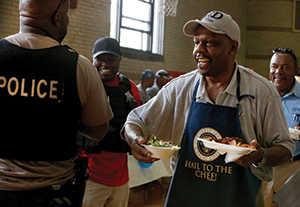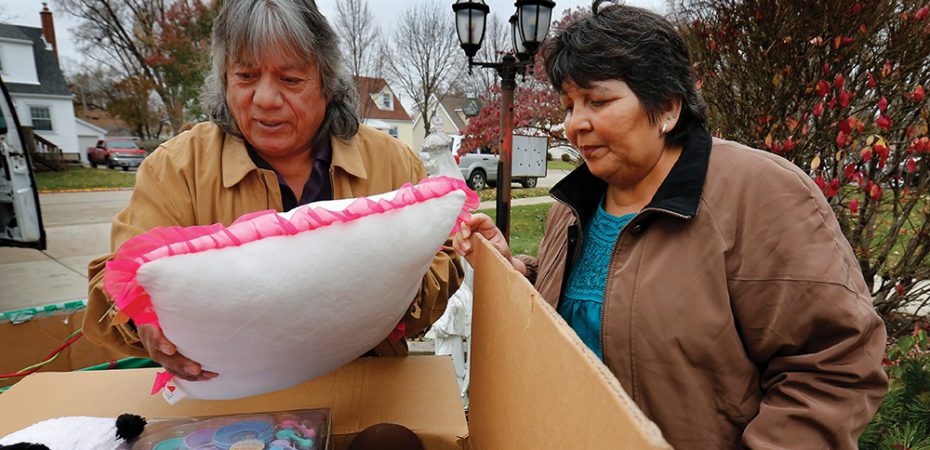Deacon as Minister of Potency
The diaconate’s special care of the evangelization and sanctification dimensions of the laity’s life
David W. Fagerberg 1
The role of the laity was recognized with greater clarity and emphasis at the Second Vatican Council. I do not suggest that an appreciation of the laity was ever lacking, but their role in the Church was given new attention. This is evident in several of the most important documents of the Council.
The Dogmatic Constitution on the Church (Lumen Gentium) says, “What specifically characterizes the laity is their secular nature. … They live in the world, that is, in each and in all of the secular professions and occupations. They live in the ordinary circumstances of family and social life … [and] they are called there by God that by exercising their proper function and led by the spirit of the Gospel they may work for the sanctification of the world from within as a leaven” (No. 31).
Similarly, the Pastoral Constitution on the Church in the Modern World (Gaudium et Spes) urges that “all the earthly activities of the faithful will be bathed in the light of the Gospel” (No. 43). The Christian is conformed to the likeness of the Son and has received the first fruits of the Spirit “by which he becomes capable of discharging the new law of love” (No. 22).
Probably the least read document of the Second Vatican Council is the Decree on the Apostolate of the Laity (Apostolicam Actuositatem). The first thing it affirms is that the laity’s apostolate derives from the Christian vocation, and the Church can never be without it. What is the apostolate? A fulfillment of the mission of the Church. What is the mission of the Church? “The Church was founded for the purpose of spreading the kingdom of Christ throughout the earth for the glory of God the Father, to enable all men to share in His saving redemption, and that through them the whole world might enter into a relationship with Christ. All activity of the Mystical Body directed to the attainment of this goal is called the apostolate” (No. 2).
This small sampling indicates that Vatican II does not think that lay people only “do their duty,” so to speak, when they come to Mass. They are directed to penetrate and perfect the temporal order, the world in which they live day by day. This is done by faith, hope and charity; and it is done by activity directed to the evangelization and sanctification of all human beings. And I am suggesting that the diaconate has special care of this dimension of the laity’s life.
Cleric Leading a Lay Life
I am a layperson and therefore seek the kingdom of God by engaging in temporal affairs, to order them according to the plan of God, to live in the ordinary circumstances of family and social life, and to be tightly bound up in all types of temporal affairs. What a wonder of grace, what generosity of providence, that the Church has given me the ministerial service of a cleric for my world. In the words of James Keating’s short definition, “A deacon is a cleric who leads a lay life.” The deacon is a minister of the Church who remains intimately familiar with the temporal order in which we live.
We find the deacon where we stereotypically expect to find him: in places of Christian education, busy with parochial works of charity, present in the halls of both diocesan services and the business world. He is communicating faith, promoting life, bringing the light of the Gospel. Imagining him doing his diaconate of word and charity here is easy because the temporal world is in such desperate need of a message of grace and works of love. But he has a third diaconia, the diaconate of the liturgy, and it is my purpose to see how these two connect with that third.
……………………………………………………………………………………………………………………………………….
The Role of Deacons
At a lower level of the hierarchy are deacons, upon whom hands are imposed “not unto the priesthood, but unto a ministry of service.” For strengthened by sacramental grace, in communion with the bishop and his group of priests they serve in the diaconate of the liturgy, of the word, and of charity to the people of God. It is the duty of the deacon, according as it shall have been assigned to him by competent authority, to administer baptism solemnly, to be custodian and dispenser of the Eucharist, to assist at and bless marriages in the name of the Church, to bring Viaticum to the dying, to read the Sacred Scripture to the faithful, to instruct and exhort the people, to preside over the worship and prayer of the faithful, to administer sacramentals, to officiate at funeral and burial services. Dedicated to duties of charity and of administration, let deacons be mindful of the admonition of Blessed Polycarp: “Be merciful, diligent, walking according to the truth of the Lord, who became the servant of all.”
— Lumen Gentium, No. 29
……………………………………………………………………………………………………………………………………
It would not be out of place to describe the layperson’s labor as “consecrating the world.” In saying that, I have in mind what Pope Paul VI meant. He gave a general audience in 1969 that has been titled “Layman Should Be World’s Perfect Citizen.” In it, he explains what consecrating the world means, and what it does not mean. It does not mean “the separation of a thing from what is profane in order to reserve it exclusively, or particularly, for the Divinity.”
We sometimes only think of consecration in this way, because sometimes when a thing or person is consecrated, it is taken out of ordinary use. But St. Paul VI says he means consecration in a wider sense. Consecration is “the re-establishment of a thing’s relationship to God according to its own order, according to the exigency of the nature of the thing itself, in the plan willed by God.” He notes that the world he is talking about is the temporal order with its natural and positive values. The world is the whole human family and the reality in which it lives.
A layperson should consecrate the little piece of the world for which he or she is responsible. That temporal world is full of graces and sins, blessings and infidelities, joys and sorrows. It is composed of actions and things, all of which should be established in relationship to God.
To aid us in this task, the Church has given us an ordained servant, and the deacon’s ministry of word and charity can be so described. It is directed to the consecration of the world. But if my temporal life is to be reoriented to God, then I must bring my whole world with me when I worship God. I do not leave the world to worship God, I worship God with my entire world. And so, the deacon, who conducts his diaconia of word and charity beside me in the temporal world, also leads me by his diaconia of liturgy to the altar of the Lord. The three ministries are tightly connected.
Architectural Symbolism
There is a symbolism in the architecture of the Church that helps illustrate this. Churches are divided into three parts: the narthex, the nave and the sanctuary. The narthex symbolizes the world, the nave symbolizes the Church, the sanctuary symbolizes heaven. The narthex is a threshold, the boundary between the world and the Church. The nave is so-called because it is the ship (navis), the ark that carries Christians across the waves of this world to their home. And the sanctuary is a symbol of our destination. It is heaven, it is the holy of holies, it houses the altar table, which is the place of sacramental sacrifice.
A Church Father named Maximus the Confessor wrote a mystagogic piece on the liturgy in the sixth century, and he proposes an interesting description of the relationship between sanctuary and nave. The nave is not an escape from the world, or, if it is, it is not a very successful escape, because, at the end of each Mass, the Christian is thrown back into the world upon the dismissal. So Maximus asserts the unity of the whole building. The Christian Church is divided into two rooms, but it is a single temple. The division does not destroy the unity. In the same way that soul and body are not “parts” of a person, the sanctuary and nave are not “parts” of the Church. Together soul and body make the whole person; together sanctuary and nave make the whole Church. So how shall we understand the relationship between heaven and earth, sanctuary and nave?
……………………………………………………………………………………………………………………………………….
Who Is a Deacon?
A deacon is an ordained minister of the Catholic Church. There are three groups, or “orders,” of ordained ministers in the Church: bishops, presbyters and deacons. Deacons are ordained as a sacramental sign to the Church and to the world of Christ, who came “to serve and not to be served.”
The entire Church is called by Christ to serve, and the deacon, in virtue of his sacramental ordination and through his various ministries, is to be a servant in a servant-Church.
— “Frequently Asked Questions About Deacons,” usccb.org
………………………………………………………………………………………………………………………………………
Maximus proposes that the nave is the sanctuary in potency, and the sanctuary is the nave in act. He is thinking of potency as a capacity to become something. An acorn is a potential oak tree, marble has the potential to be made into a statue, a baby has the potency to walk and speak, even if he can’t do it right now. And the human being into which that baby will grow has the potential to be a saint.
Created in the image of God, we are meant to be transfigured into the likeness of God. We are created with a potency for spiritual things. Earth is destined for heaven, time is fulfilled in eternity, our bodies are made for resurrection. When the potential of creation is realized in the final act, we will find ourselves standing in the heavenly Jerusalem.

Sanctuary and Nave
The laity come to Church each week, bringing their world with them in order to consecrate it, give it to God. They have been given reserve seating in the nave by their baptism. It is their location for full, active and conscious participation in the liturgy. The priest and deacon conduct their liturgy in the sanctuary, the layperson conducts his liturgy in the nave. But Maximus’ rule applies again: it is one unified liturgy, and not divided into parts.
Both priest and deacon stand in the sanctuary, a space reserved for the ordained. They each perform the hierarchically assigned ministry they were given at ordination. A recommended homily in the Rite of Ordination contains this description: “As ministers of the altar, [deacons] will proclaim the Gospel, prepare the Sacrifice, and distribute the Lord’s Body and Blood to the faithful.” And “bound more closely to the service of the altar, they will perform works of charity in the name of the Bishop or the pastor.” The deacon has a ministry at the altar from which flows his ministry of word and charity.
When I leave the Mass, as the rhythm of my lay life demands, the deacon follows me into my other place, my first place, my original location in the world. I have stood in the nave and experienced the potential creation that has to be raised up to God. The Church is the world in its course of transfiguration. But now I return to the temporal world, and when I do, the deacon comes out of the sanctuary, through the nave, across the narthex, and accompanies me into the secular realm where I live, for he also has an assignment there. He promotes and sustains the apostolic activities of the laity; he intimately knows the circumstances of a ministry of charity; he evangelizes, catechizes and renews; he reconciles and restores; he preaches the Gospel always, sometimes using words (as Deacon Francis of Assisi famously said). Then, next week, he will help me carry my temporal world into the nave where I will again discover its potency for heaven.
Minister of Potency

Since the deacon stands with one foot in the sanctuary, even while ministering in locked churches during the COVID-19 crisis, and one in the temporal world, he may be called a minister of potency. When he performs his diaconia of word and diaconia of charity, they are never separated from his diaconia of liturgy. In his own clerical person, he establishes a connection between the lay apostolate in the temporal realm and the liturgy in the sanctuary. By his ministry in the temporal realm, he conducts the laity into the nave, where they bring their world as sacrifice to be consecrated. By his ministry in the sanctuary, he points everything to its heavenly actualization.
The deacon walks with people in the world, wherever they are in the world, as long as they are on the pathway of the world. There he exercises his twin ministries of word and charity. But to what end? For what purpose? Where would he lead the laity if it was not to the altar, the sanctuary, to heaven? He is a minister of potency. His job is to develop the spiritual faculties of the laity so they can consecrate the world. That is why we cannot make any sense of the diaconate without its liturgical leg.
DAVID W. FAGERBERG is professor of liturgical theology at the University of Notre Dame.






Comments are closed.